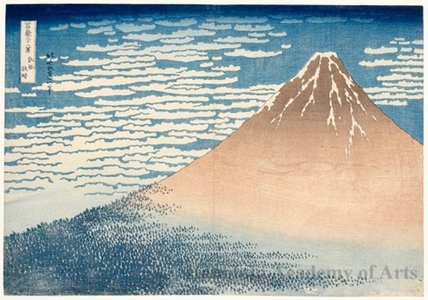Estampe japonaise "Mount Fuji in Clear Weather, or Red Fuji" par Katsushika Hokusai
Artiste :Katsushika Hokusai
Titre :Mount Fuji in Clear Weather, or Red Fuji
Date :c. 1830 - 1834
Détails :Plus d'informations...
Source :Honolulu Museum of Art
Parcourir toutes les 5 476 estampes...
Description :
Gaifü Kaisei (literally, clear day with a southern breeze) is commonly known as Mount Fuji at Dawn, or the shorter Red Fuji. Here the mountain rises in the right third of the composition, extending in a long ridge to the left bottom. The base is covered densely with trees, here reduced to tiny dots. Among the many works depicting Mount Fuji, none surpasses this powerful and pleasant rendering. It is said that Fuji takes on a red color in early morning and around sunset. It looks best when bright red, which occurs under special conditions when many small, undulating clouds float in the clear sky. The abundance of clouds in this composition indicates that Hokusai had actually seen Mount Fuji in these conditions. Mount Fuji is not actually this steep – its slopes are less than 45 degrees – but Hokusai made it steep toward the peak for dramatic effect. The simple color scheme is limited to red-brown, blue, white, and two shades of green. The composition overall demonstrates that the most powerful and effective composition does not require complexity. (The Asian Art Museum of San Francisco, HOKUSAI AND HIROSHIGE – Great Japanese Prints from the James A. Michener Collection, Honolulu Academy of Arts: The Asian Art Museum of San Francisco, 1998 Page 56, Cat. 7) ******************************* Despite its simplicity, this is one of Hokusai’s most powerful depictions of Mount Fuji. The mountain is said to take on a red color at dawn in the late summer or early fall, in the rays of the rising sun. An auspicious sight, depictions of Red Fuji became popular among literati artists and intellectuals in the Edo period as worship of the mountain spread. The Japanese title of this work is Gaifü Kaisei, which literally means “southern breeze in clear weather.” According to its original Chinese meaning, gaifü (southern breeze) is the wind that blows in early summer, bestowing longevity upon all living things. Hokusai here likens Mount Fuji to the legendary Mount Hörai, an isle of eternal youth in Chinese mythology. Traditionally believed to be in the sea to the east of China (like Japan itself), with cliffs so steep it could only be reached by flying on the back of a crane, Mount Hörai offered a vision of freedom from toil and political intrigue to both Chinese and Japanese intelligentsia, and was a popular subject in the arts. “Hokusai’s Summit: Thirty-six Views of Mount Fuji” (09/24/2009-01/06/2010) ******************************
Estampes Similaires









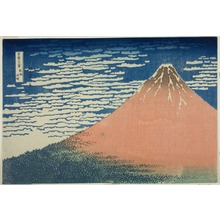







![Gaifu kaisei 凱風快晴 (South Wind, Clear Sky ['Red Fuji']) / Fugaku sanju-rokkei 冨嶽三十六景 (Thirty-six Views of Mt. Fuji) Estampe japonaise "Gaifu kaisei 凱風快晴 (South Wind, Clear Sky ['Red Fuji']) / Fugaku sanju-rokkei 冨嶽三十六景 (Thirty-six Views of Mt. Fuji)" par Katsushika Hokusai, 葛飾北斎 (Katsushika Hokusai (葛飾北斎))](https://data.ukiyo-e.org/bm/thumbs/AN00102568_001_l.jpg)










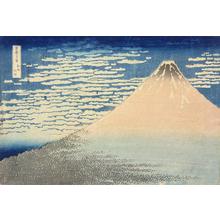
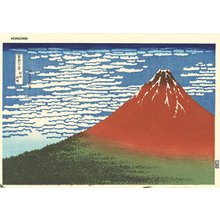
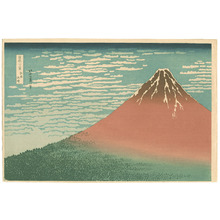

![[Gaifū kaisei] Estampe japonaise "[Gaifū kaisei]" par Katsushika Hokusai, 葛飾北斎 (Katsushika Hokusai)](https://data.ukiyo-e.org/loc/thumbs/02486v.jpg)



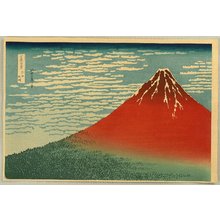


![[View of Mount Fuji]- From: 36 Views of Fuji Estampe japonaise "[View of Mount Fuji]- From: 36 Views of Fuji" par Katsushika Hokusai, 葛飾北斎 (Katsushika Hokusai)](https://data.ukiyo-e.org/famsf/thumbs/5050161217180074.jpg)

